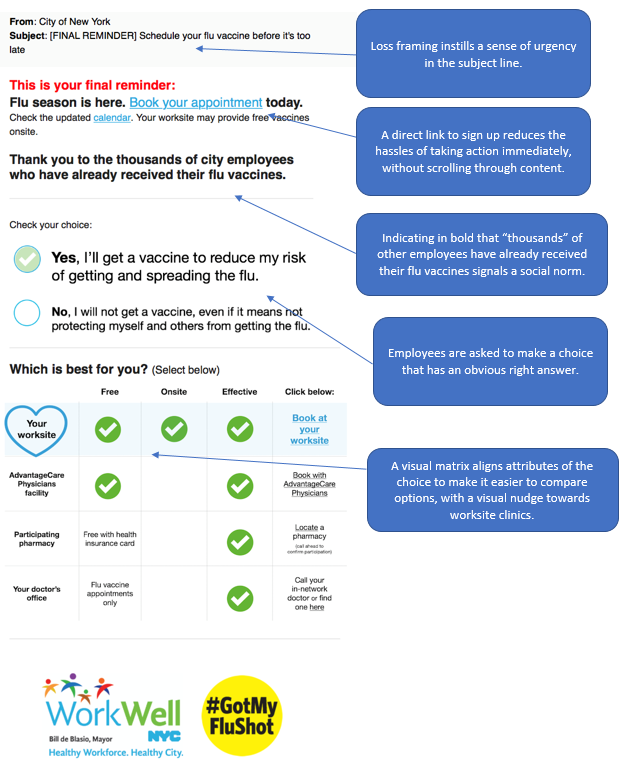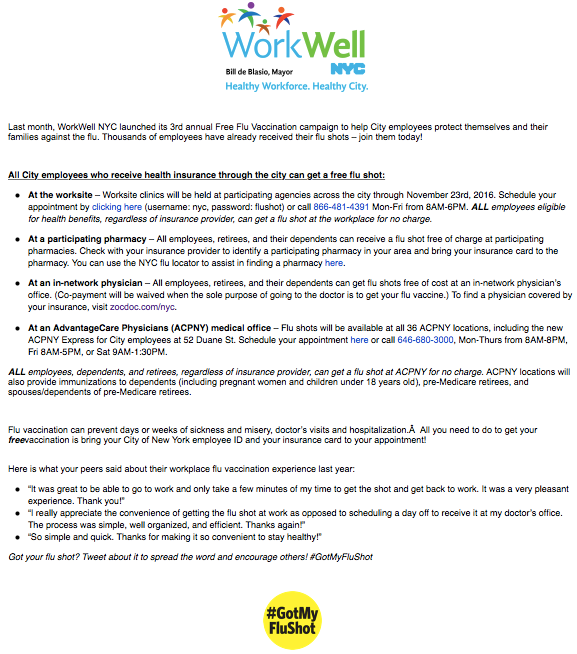
Behavioral Emails Increase Flu Vaccine Uptake among City Employees
Organization : ideas42
Project Overview
Project Summary
To increase uptake of flu vaccines and maintain a healthy workforce during the 2016-17 flu season, New York City’s Behavioral Design Team (NYC BDT) partnered with WorkWell NYC to design behaviorally informed emails to encourage New York City employees to visit a worksite flu clinic. One version of the redesigned email used the strategy of “enhanced active choice,” whereby employees were prompted to make a choice that had a clear right answer.
Impact
Behavioral emails more than doubled click-through rates and statistically increased appointment sign-ups. Most importantly, the enhanced active choice version of the email increased vaccine uptake by 5 percent at worksite locations.
Cost
There was no additional cost to WorkWell NYC because emails were already being circulated. However, an outside vendor was paid to collect data at worksites during the pilot in order to conduct the randomized controlled trial.
Source
Source
Challenge
Thousands of flu-related hospitalizations and deaths occur each year. Despite these dangers, only 21 percent of New York City employees received flu shots in the 2015-2016 flu season. Among nearly 900,000 City employees, pre-Medicare retirees, and their family members enrolled in City-provided health insurance, over 700,000 of enrollees went unprotected from the flu, risking their own health and spreading the flu to others.
Design
As a part of a dedicated effort to lower healthcare costs and increase the uptake of preventive care, New York City’s Behavioral Design Team (NYC BDT) partnered with WorkWell NYC – the City’s workplace wellness program within the Office of Labor Relations (OLR) – to design behaviorally informed emails to encourage New York City employees to visit a worksite flu clinic.
The redesigned emails, A and B, made it easy to know what to do and how to do it. At the very top was the immediate action item to book your appointment with a link. The decision framework also made it visually easy to compare options for where to get a vaccine using graphics and direct links, and included a nudge towards on-site flu clinics. In addition, social norms were highlighted, by referring to the thousands of city employees that get flu vaccines.
Email B (pictured below) had all the same elements of Email A, but also used the strategy of “enhanced active choice,” whereby employees were asked to make a choice between: “Yes, I’ll get a vaccine to reduce my risk of getting and spreading the flu” or “No, I will not get a vaccine, even if it means not protecting myself and others from getting the flu.” By clicking “Yes”, City employees were directed to the website where they could make an appointment to receive a vaccine at their closest worksite clinic.

Annotated Email B
City employee email addresses were randomized into one of three groups – 1) redesigned Email A, 2) redesigned Email B, or 3) standard WorkWell NYC email – and received three emails over a two-month period. The first email was sent on September 14, 2016; the second on October 6, 2016; and the final on October 18, 2016. The primary outcomes for measurement were 1) online pre-registration for onsite flu vaccines and 2) actual uptake of vaccines at onsite flu clinics. We were not able to consider whether these emails influenced employees to uptake vaccines at alternative locations to the worksite clinics.

Standard WorkWell NYC email
Impact
Both behaviorally informed emails doubled click through rates on the registration link for worksite appointments. More importantly, the email with enhanced active choice (B) increased pre-registrations by 12 percent and increased flu vaccine uptake at worksite clinics by 5 percent.
Based on these results, WorkWell NYC deployed the behaviorally informed email to all employees, and has seen a 10 percent increase in worksite flu vaccinations.
Implementation Guidelines
Inspired to implement this design in your own work? Here are some things to think about before you get started:
- Are the behavioral drivers to the problem you are trying to solve similar to the ones described in the challenge section of this project?
- Is it feasible to adapt the design to address your problem?
- Could there be structural barriers at play that might keep the design from having the desired effect?
- Finally, we encourage you to make sure you monitor, test and take steps to iterate on designs often when either adapting them to a new context or scaling up to make sure they’re effective.
Additionally, consider the following insights from the design’s researcher:
- Enhanced active choice presents a choice where the right answer is obvious and the wrong choice prompts employees to consider the consequences of their actions.
- Writing a letter or email? Make sure to check out B-Hub’s best practices checklist.
Project Credits
Researchers:
Rachel Rosenberg ideas42
Jon Hayes ideas42
Anthony Barrows ideas42
Natalie Dabney ideas42


